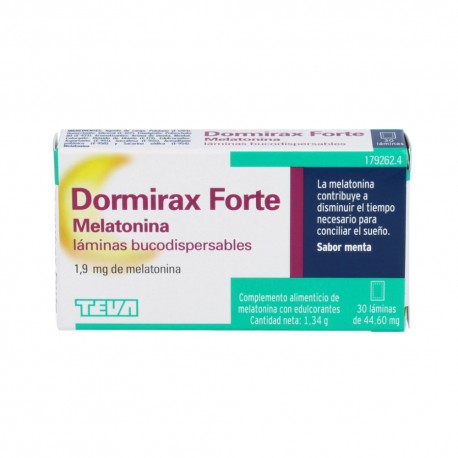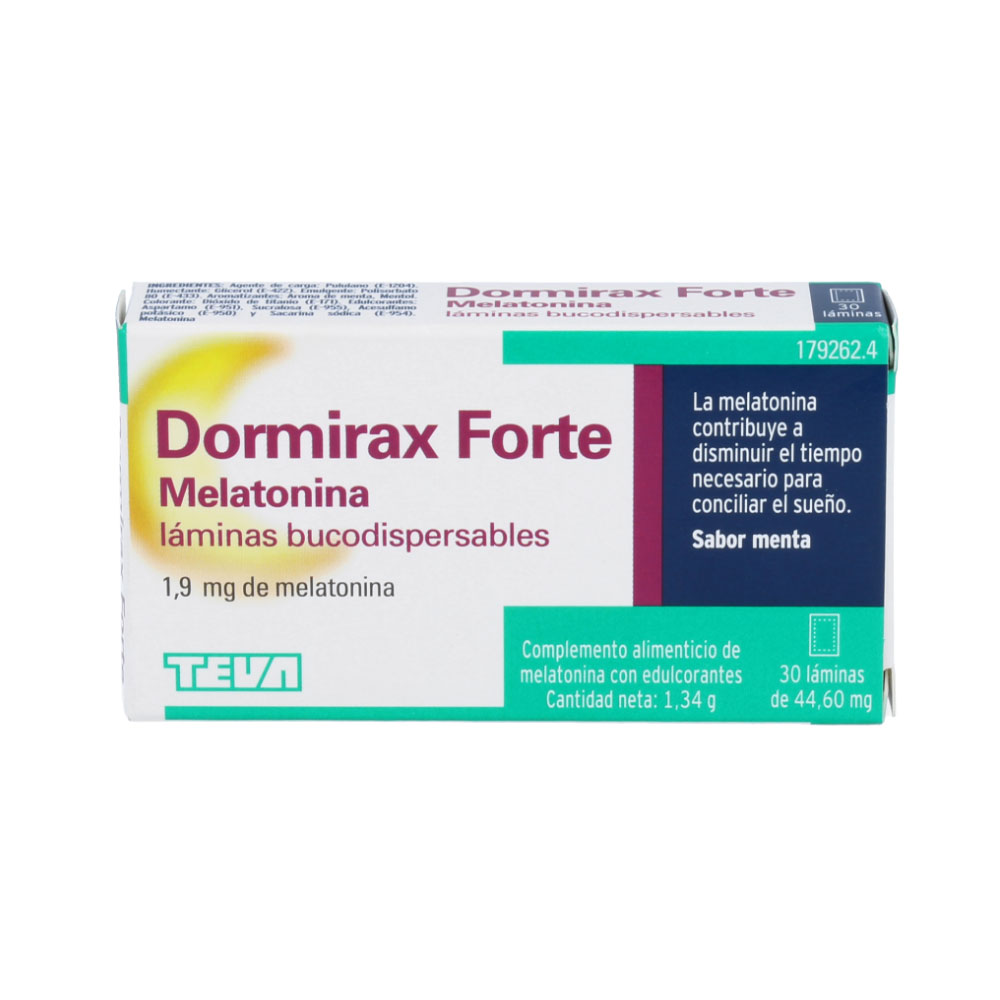Dormirax Forte 1.9mg 30 Oral Dispersible Sheet
Reference: 8470001792624 179262
Manufacturer: Teva
Melatonin helps reduce the time needed to fall asleep. Mint flavor.
This product is no longer in stock
More info
Dormirax Forte Melatonin orodispersible Sheet - (1.90 Mg 30 Sheets)
ACTION AND DESCRIPTION
Melatinin helps reduce the time needed to fall asleep. The beneficial effect is an intake of 1 mg of melatonin shortly before going to sleep. Melatonin helps alleviate the subjective feeling of lag time (jet lag). The beneficial effect is obtained with a minimum intake of 0.5 mg that should be taken shortly before bedtime on the first day of travel and a few days after arrival.
INGREDIENTS
Melatonin (1 mg / 1.90 mg per sheet).
Charging agent: pululane (E-1204), humectant: glycerol (E-422), emulsifier: polysorbate 80 (E-433), flavoring: mint aroma; colorant: titanium dioxide (E-171), flavoring: menthol, sweeteners: aspartame (E-951), sucralose (E-955), potassium acesulfame (E-950) and sodium saccharin (E-954).
MIDDLE ANALYSIS
Per sheet:
Proteins: 0.80 mg
Carbohydrates: 38.87 mg
- sugars: 0.089 mg
Lipids: 0.17 mg
- saturated: 0.0169 mg
Food fiber: 0.045 mg
Sodium: 0.0074 mg
ENERGY
0.160 Kcal / 0.68 kJ
HOW TO USE
Put a sheet on the tongue half an hour before bedtime, the sheet will dissolve quickly with saliva. It is not necessary to drink water.
PRECAUTIONS AND WARNINGS
The expiration date refers to the product properly preserved and unopened. Keep out of reach and sight of children. Do not take during pregnancy or breastfeeding. Do not exceed the daily dose expressly recommended. Food supplements should not be used as a substitute for a varied and balanced diet and a healthy lifestyle.
CONSERVATION AND EXPIRATION
Store in a cool dry place and away from heat sources.
OTHERS
According to the Report of the Scientific Committee of the Spanish Agency for Consumption, Food Safety and Nutrition (AECOSAN) on conditions of use of certain substances to be used in food supplements: Melatonin
AECOSAN has proposed a maximum daily amount for melatonin of 1 mg. This proposal is based on the authorization of two health claims, in relation to melatonin contributing to
• relieve the subjective feeling of lag time:
It can only be used with foods that contain a minimum of 0.5 mg of melatonin per quantized serving. In order for a product to carry this declaration, the consumer will be informed that the beneficial effect is obtained with a minimum intake of 0.5 mg that must be taken shortly before bedtime on the first day of travel and a few days after arrival at the place of destination (EU, 2012).
• melatonin helps reduce the time needed to fall asleep
It can only be used with foods containing 1 mg of melatonin per quantized serving. In order for a product to carry this declaration, the consumer will be informed that the beneficial effect is obtained with an intake of 1 mg of melatonin shortly before going to sleep (EU, 2012).
Melatonin (N-acetyl-5-methoxytryptamine) is a neurohormone produced by the pineal gland of mammals and other organs, especially enterochromaffin cells of the gastrointestinal tract and retina (Hardeland et al., 1993) (Huether, 1993), whose The main physiological function is the regulation or control of circadian and seasonal rhythms (Armstrong et al., 1986). It was discovered in the fifties (Lerner et al., 1958, 1959).
In recent years it has been shown that melatonin also has numerous other additional functions, is produced and acts in numerous tissues or cells that express melatonin receptors, at much lower levels (Hardeland, 2009). MT1 and MT2 melatonin receptors (membrane receptors) have been detected in numerous tissues of the CNS (Central Nervous System), in peripheral organs such as the gastrointestinal tract, liver, lung, skin, adrenal gland, gonads, male organs, breast tissue , kidney, heart, blood vessels, adipose tissue, neutrophils, lymphocytes and lymphoid tissue (Ishii et al., 2009). Both receptors involve signaling through cAMP inhibition, protein kinase A activity, effects on phospholipase A2 and C, and effects on potassium and calcium channels (Mathes, 2010). A third receptor, MT3, which is an enzyme identified as quinone reductase 2, has also been described.
Deficiencies in melatonin production or receptor expression or decreases in melatonin levels (such as those that occur with age) cause numerous dysfunctions. In these cases, with insufficient levels of melatonin or poor melatoninergic signaling, numerous pathophysiological alterations may occur, reflecting the pleiotropy of the molecule. Thus, for example, a decrease in nocturnal melatonin levels has been repeatedly observed in patients with neurodegenerative disorders and who have sleep disturbances (Uchida et al., 1996).
USE IN PATIENTS WITH FOOD INTOLERANCE
This product can be taken by a celiac person, allergic / intolerant to eggs, or intolerant to milk.
It contains a source of phenylalanine.





